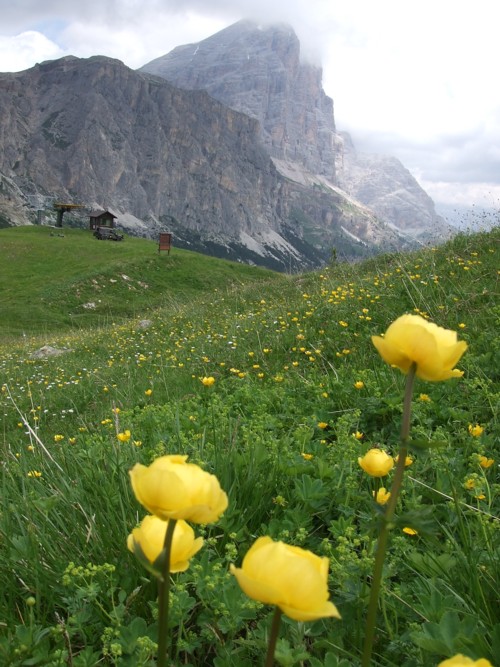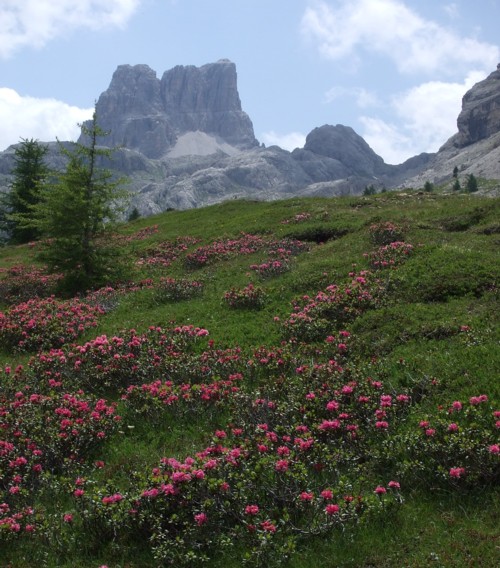Where are the Dolomites?
The Dolomites (le Dolomiti) are a series of mountain groups in north-eastern Italy, in the Italian Alps. They are the spikiest mountains in Europe, frequently standing in as film locations for stories set in mountains which are inconveniently remote or just less spectacular like the Rockies. Made of a particularly rough grey stone, the Dolomite summits typically soar up from the surrounding forests and pastures in blocks, towers and pinnacles, which are famous for going pink or bronze at sunset.
The mountains are well served by the roads which go round their flanks and have attracted a lot of skiing development, including a more-than-usual ration of steep and challenging runs. Other active sports in the Dolomites include cycling, white-water, climbing (of course) and the use of vie ferrate, arrangements of chains, ladders, cables and artificial hand-holds by which the not-quite-a-climber can tackle desperately exposed routes. Less ambitious walkers can find footpaths in the valleys and use various lifts and bus services to reach higher ground.

Holidays in the Dolomites
Being a popular great-outdoors holiday destination, the Dolomites are better mapped than most of Italy. As part of the Alps, they also have a good sprinkling of traditional mountain restaurants and of rifugi which provide sustenance for the day visitor as well as beds and bunks for hardier souls. Most of the area was once Austrian: German is still frequently spoken, and the region as a whole has a part-Italian part-Austrian flavour. The scars of a bitter high-altitude war in 1914-18 are still evident in the landscape, some carefully restored as a tourist attraction, the rest simply there to be found by the walker or climber.
Where to stay in the Dolomites

Among individual centres for the tourist, the most important is Cortina dAmpezzo, which made its name (and that of a British saloon car) in the 1956 Winter Olympics. The town has lurking ambitions for a second go at these. Cortina lies among the easternmost Dolomites, with its neighbour Dobbiaco – where there is less skiing but more mountain walking – at their northern edge. This area is best reached from Treviso Airport, otherwise Venice or Trieste. Further west are the Central Dolomites, around Selva di Gardena, Canazei and the Val di Fassa, accessible from Brescia and Verona as well as from Treviso. This is a particularly wide skiing zone, with linked facilities and coordinated transport.
Farthest west are the Brenta Dolomites, probably the quietest, which also border the dauntingly high and unspoilt (but not really Dolomitic) Adamello-Presanello Group. There’s no natural centre for the Brenta Dolomites, but Madonna di Campiglio is likely to be best for skiers and Lake Molveno or Pinzolo for anyone wanting a quieter time. Brescia is a good jumping-off point once again, but Milan and Bergamo airports are also possibles. Appropriately enough for a province which was once the South Tyrol, both these and the Central Dolomites can be reached from (present-day) Austria over the Brenner Pass.
Why are they called the Dolomites?
The Dolomites take their name from a French geologist and intellectual, Dieudonné (or Déodat) de Dolomieu, who is commemorated with a monument in Cortina. He was the first to examine and describe the particular kind of limestone which characterises these mountains, chemically different from other limestones. By no means all of the eastern Alps of Italy are made of this none, for example, of the high land along the Austrian border. And the same kind of limestone does crop up here and there in other places, including a rather distant cousin in Yorkshire.
> Hotels, B&Bs and holiday rentals in the Dolomites
On this site
Useful links
